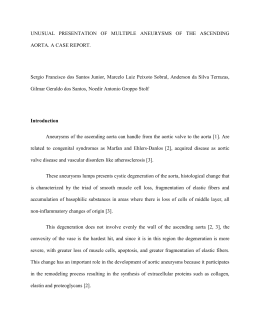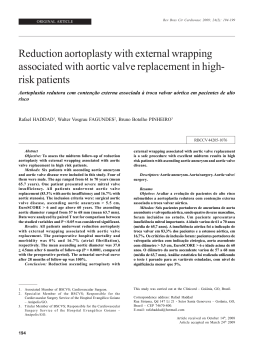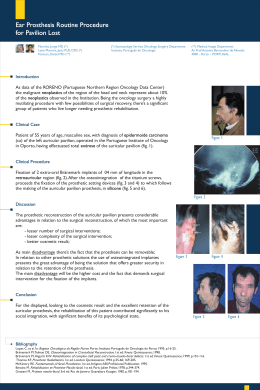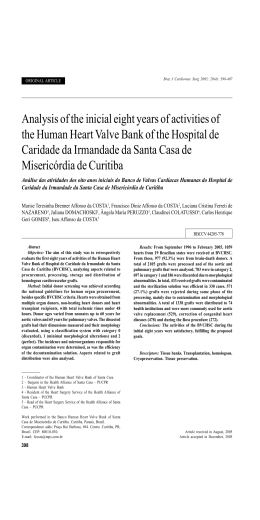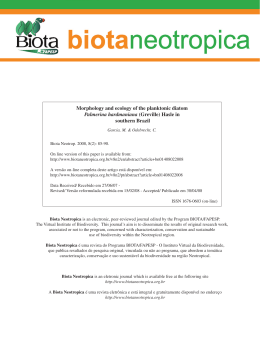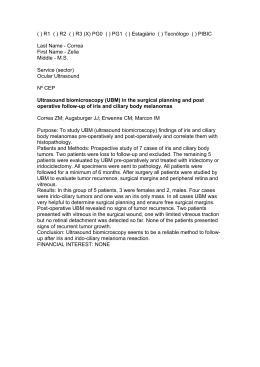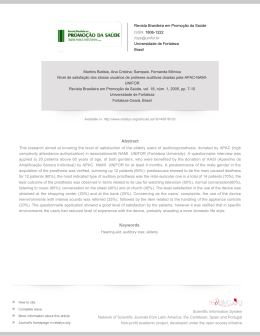JOURNAL OF THE AMERICAN COLLEGE OF CARDIOLOGY
VOL. 65, NO. 20, 2015
ª 2015 BY THE AMERICAN COLLEGE OF CARDIOLOGY FOUNDATION
PUBLISHED BY ELSEVIER INC.
ISSN 0735-1097/$36.00
http://dx.doi.org/10.1016/j.jacc.2015.03.014
Transcatheter Versus Surgical
Aortic Valve Replacement in Patients
With Severe Aortic Valve Stenosis
1-Year Results From the All-Comers NOTION
Randomized Clinical Trial
Hans Gustav Hørsted Thyregod, MD,* Daniel Andreas Steinbrüchel, MD, DMSC,* Nikolaj Ihlemann, MD, PHD,y
Henrik Nissen, MD, PHD,z Bo Juel Kjeldsen, MD, PHD,x Petur Petursson, MD,k Yanping Chang, MS,{
Olaf Walter Franzen, MD,y Thomas Engstrøm, MD, DMSC,y Peter Clemmensen, MD, DMSC,y Peter Bo Hansen, MD,#
Lars Willy Andersen, MD, DMSC,# Peter Skov Olsen, MD, DMSC,* Lars Søndergaard, MD, DMSCy
ABSTRACT
BACKGROUND Transcatheter aortic valve replacement (TAVR) is an option in certain high-risk surgical patients with
severe aortic valve stenosis. It is unknown whether TAVR can be safely introduced to lower-risk patients.
OBJECTIVES The NOTION (Nordic Aortic Valve Intervention Trial) randomized clinical trial compared TAVR with surgical aortic valve replacement (SAVR) in an all-comers patient cohort.
METHODS Patients $70 years old with severe aortic valve stenosis and no significant coronary artery disease were
randomized 1:1 to TAVR using a self-expanding bioprosthesis versus SAVR. The primary outcome was the composite rate
of death from any cause, stroke, or myocardial infarction (MI) at 1 year.
RESULTS A total of 280 patients were randomized at 3 Nordic centers. Mean age was 79.1 years, and 81.8% were
considered low-risk patients. In the intention-to-treat population, no significant difference in the primary endpoint was
found (13.1% vs. 16.3%; p ¼ 0.43 for superiority). The result did not change in the as-treated population. No difference in
the rate of cardiovascular death or prosthesis reintervention was found. Compared with SAVR-treated patients, TAVRtreated patients had more conduction abnormalities requiring pacemaker implantation, larger improvement in effective
orifice area, more total aortic valve regurgitation, and higher New York Heart Association functional class at 1 year. SAVRtreated patients had more major or life-threatening bleeding, cardiogenic shock, acute kidney injury (stage II or III), and
new-onset or worsening atrial fibrillation at 30 days than did TAVR-treated patients.
CONCLUSIONS In the NOTION trial, no significant difference between TAVR and SAVR was found for the composite rate
of death from any cause, stroke, or MI after 1 year. (Nordic Aortic Valve Intervention Trial [NOTION]; NCT01057173)
(J Am Coll Cardiol 2015;65:2184–94) © 2015 by the American College of Cardiology Foundation.
From the *Department of Cardiothoracic Surgery, The Heart Centre, Rigshospitalet, Copenhagen University Hospital, Copenhagen, Denmark; yDepartment of Cardiology, The Heart Centre, Rigshospitalet, Copenhagen University Hospital, Copenhagen,
Denmark; zDepartment of Cardiology, Odense University Hospital, Odense, Denmark; xDepartment of Cardiothoracic and Vascular
Surgery, Odense University Hospital, Odense, Denmark; kDepartment of Cardiology, Sahlgrenska University Hospital, Gothenburg, Sweden; {Department of Statistics, Medtronic Inc., Mounds View, Minnesota; and the #Department of Cardiac Anesthesia,
The Heart Centre, Rigshospitalet, Copenhagen University Hospital, Copenhagen, Denmark. The Danish Heart Foundation provided financial support (grants: 09-10-AR76-A2733-25400, 12-04-R90-A3879-22733 and 13-04-R94-A4473- 22762). Dr. Steinbrüchel
has received research contracts from Medtronic, Inc. Dr. Ihlemann has received speaker fees from Medtronic, Inc. Dr. Chang is an
employee of Medtronic, Inc. Dr. Franzen has received research contracts from St. Jude Medical, Inc. Dr. Clemmensen has received
research contracts and speaker fees from Medtronic, Inc. Dr. Hansen has received speaker fees from Medtronic, Inc. Dr. Olsen has
received research contracts from Medtronic, Inc. and St. Jude Medical, Inc. Dr. Søndergaard is a proctor for Medtronic, Inc.; has
received research contracts from Medtronic, Inc. and St. Jude Medical, Inc.; and has received speaker fees from Medtronic, Inc. All
other authors have reported that they have no relationships relevant to the contents of this paper to disclose.
Manuscript received February 16, 2015; revised manuscript received March 3, 2015, accepted March 4, 2015.
Downloaded From: http://content.onlinejacc.org/ by Layla Caitano on 05/19/2015
Thyregod et al.
JACC VOL. 65, NO. 20, 2015
MAY 26, 2015:2184–94
A
2185
Transcatheter Versus Surgical Aortic Valve Replacement
ortic valve stenosis is the most prevalent
consent. The investigators collected and
ABBREVIATIONS
heart valve disease in the Western world,
stored all data, which were fully monitored
AND ACRONYMS
and it has a poor prognosis after symptom
by an independent monitoring unit. An in-
onset (1–3). Previously, surgical aortic valve replace-
dependent clinical events committee adjudi-
ment (SAVR) was the only effective treatment, but af-
cated all clinical events. An independent
ter being introduced in 2002, transcatheter aortic
statistician confirmed the statistical analysis.
valve replacement (TAVR) became an option for
All authors confirm that the trial was con-
certain patients with severe symptomatic aortic valve
ducted according to the protocol, and they
stenosis that was considered inoperable or in patients
vouch for the accuracy and completeness of
at high risk for surgical complications (4,5). More
the data and analyses.
AF = atrial fibrillation
AKI = acute kidney injury
CAD = coronary artery disease
CT = computed tomography
2DE = 2-dimensional
transesophageal
echocardiography
EuroSCORE = European
recently, observational studies have demonstrated
System for Cardiac Operative
and
PATIENT SELECTION. Patients $70 years of
Risk Evaluation
intermediate-risk patients (6–10); however, no ran-
age with severe degenerative aortic valve
MI = myocardial infarction
domized clinical trials have been conducted in this
stenosis referred for SAVR and also candi-
NYHA = New York Heart
patient population.
dates for TAVR were eligible for inclusion
Association
acceptable
mortality
outcomes
in
low-
SEE PAGE 2195
Different TAVR systems have been developed, and
currently
self-expandable
or
regardless of their predicted risk of death af-
SAVR = surgical aortic valve
ter surgery. A heart team consisting of at least
replacement
STS-PROM = Society of
an imaging cardiologist, an interventional
Thoracic Surgeons Predicted
balloon-expandable
cardiologist, and a cardiac surgeon evaluated
bioprostheses are used. Patients undergoing TAVR
all patients. Severe aortic valve stenosis was
and SAVR procedures experience different spectra
defined as an effective orifice area <1 cm 2 or
valve replacement
indexed for body surface area <0.6 cm 2/m 2
TIA = transient ischemic attack
of complications related to the different nature of
the treatments. After TAVR, more patients have
prosthesis regurgitation, conduction disturbances
requiring a pacemaker, and vascular complications,
Risk Of Mortality
TAVR = transcatheter aortic
and a mean aortic valve gradient >40 mm Hg
or peak systolic velocity >4 m/s. Symptomatic patients had to have dyspnea, New York Heart Associ-
whereas SAVR-treated patients have more bleeding,
ation (NYHA) functional class II or higher, angina
acute kidney injury (AKI), and new-onset atrial
pectoris, or cardiac syncope to qualify for the trial.
fibrillation (AF) (11,12). The impact of these complications on mortality and morbidity has not been
firmly established. In high-risk patients, improved
Asymptomatic patients could be included if they had
left ventricular posterior wall thickness $17 mm,
decreasing left ventricular ejection fraction, or new-
survival was demonstrated with TAVR using a self-
onset AF. Eligible patients were expected to survive
expanding prosthesis compared with SAVR after
for more than 1 year. Patients were excluded if they
1 year (12), whereas survival was similar to findings
had another severe heart valve disease or coronary
with SAVR after 1 and 2 years when a balloon-
artery disease (CAD) requiring intervention. Other
expandable prosthesis was used (11,13).
important exclusion criteria were previous cardiac
The NOTION (Nordic Aortic Valve Intervention)
surgery, myocardial infarction (MI) or stroke within
trial is an all-comers trial evaluating the benefits and
30 days, severe renal failure requiring dialysis, or
harms of TAVR using a self-expanding prosthesis
pulmonary failure with a forced expiratory volume
versus SAVR in patients with echocardiographically
within 1 s or diffusion capacity <40% of expected.
severe aortic valve stenosis.
METHODS
Trial eligibility, choice of prosthesis size, and
arterial access route were based on transthoracic and
transesophageal echocardiograms and an aorto-ilio-
The NOTION trial was an investigator-initiated,
femoral angiogram and were confirmed by the pri-
multicenter, randomized, nonblinded, superiority
mary interventional and surgical investigator at each
trial conducted at 2 centers in Denmark and 1 in
site.
Sweden. The trial design has been described in detail
studies were performed in patients with difficult
previously (14). A total of 280 patients were randomly
aortic annular measurements or peripheral arterial
assigned to TAVR using a self-expanding prosthesis
disease.
Supplemental
computed
tomography
(CT)
versus SAVR and were followed for 5 years. The primary outcome was evaluated after 1 year.
PROCEDURES. Patients were randomized in a 1:1 ra-
The regional ethical review board at each site
tio to treatment with TAVR or SAVR. Randomization
approved the trial protocol, and the trial was con-
was performed at the Copenhagen Trial Unit and was
ducted according to the principles of the Declaration
stratified according to trial site, age (70 to 74 years or
of Helsinki. All patients provided written informed
older), and history of CAD (yes or no). The allocation
Downloaded From: http://content.onlinejacc.org/ by Layla Caitano on 05/19/2015
2186
Thyregod et al.
JACC VOL. 65, NO. 20, 2015
MAY 26, 2015:2184–94
Transcatheter Versus Surgical Aortic Valve Replacement
sequence was arranged in permuted blocks, and block
heparin during the procedure. Post-procedure, pa-
size was unknown to the investigators.
tients continued on a maintenance dose of clopidog-
Patients randomized to TAVR received the Core-
rel (75 mg/day) for 3 months and lifelong aspirin
Valve self-expanding bioprosthesis (Medtronic Inc.,
(75 mg/day). If warfarin was indicated, this was
Minneapolis, Minnesota) in sizes 23, 26, 29, or 31 mm.
continued in combination with clopidogrel for the
The preferred route of arterial access was femoral,
first 3 months, followed by lifelong aspirin.
with left subclavian access as the second choice. The
Patients randomized to SAVR underwent conven-
procedure was performed using general or local
tional open heart surgery with the use of cardiopul-
anesthesia, as described previously (15). Patients
monary bypass. All patients received a bioprosthesis,
received a loading dose of pre-procedural clopidogrel
with the specific type and size determined during
(300 mg) and aspirin (75 mg) and unfractionated
the surgical procedure. Surgical patients received a
F I G U R E 1 Patient Flow
Patients considered by
Heart Team
(n=1,576)
Excluded (n=1,296)
All Enrolled
N=280
RANDOMIZATION
ITT SAVR
N=135
ITT TAVR
N=145
Died prior to procedure
(n=3)
Crossover
TAVR to SAVR
n=1
Crossover
SAVR to TAVR
n=1
Died prior to procedure
(n=1)
TAVR
N=141
SAVR
N=133
AT TAVR
N=142
AT SAVR
N=134
Crossover TAVR to SAVR
n=3
IMPLANTED TAVR
N=139
Not implanted
n=2
IMPLANTED SAVR
N=135
After excluding 1,296 of the 1,576 originally considered patients, 280 were enrolled and randomized 1:1 to either transcatheter aortic valve
replacement (TAVR) or surgical aortic valve replacement (SAVR) and were followed for 1 year. AT ¼ as-treated population (patients with an
attempted procedure); ITT ¼ intention-to-treat population.
Downloaded From: http://content.onlinejacc.org/ by Layla Caitano on 05/19/2015
Thyregod et al.
JACC VOL. 65, NO. 20, 2015
MAY 26, 2015:2184–94
Transcatheter Versus Surgical Aortic Valve Replacement
T A B L E 1 Baseline Characteristics
T A B L E 2 Procedural Characteristics
TAVR
TAVR*
(n ¼ 145)
SAVR*
(n ¼ 135)
79.2 4.9
79.0 4.7
Total procedure time, min
90.3 38.6
78/145 (53.8)
71/135 (52.6)
Local anesthesia
26/142 (18.3)
Use of inotropes
86/142 (60.6)
I
7/144 (4.9)
3/134 (2.2)
II
67/144 (46.5)
70/134 (52.2)
Conversion to surgery
III
67/144 (46.5)
57/134 (42.5)
Transfemoral access
IV
Age, yrs
Male
NYHA functional classification
Procedural success*
139/142 (97.9)
Implantation of >1 valve prosthesis
4/142 (2.8)
3/142 (2.1)
137/142 (96.5)
Transsubclavian access
5/142 (3.5)
3/144 (2.1)
4/134 (3.0)
STS-PROM score, %
2.9 1.6
3.1 1.7
Logistic EuroSCORE, %
8.4 4.0
8.9 5.5
23 mm
2/142 (1.4)
Logistic EuroSCORE II, %
1.9 1.2
2.0 1.3
26 mm
57/142 (40.1)
7.4 1.4
7.5 1.4
29 mm
69/142 (48.6)
26/145 (17.9)
28/135 (20.7)
31 mm
14/142 (9.9)
2/145 (1.4)
1/135 (0.7)
Additive EuroSCORE, %
Diabetes mellitus
Creatinine level >2 mg/dl
History of hypertension
Valve size implanted
103/145 (71.0)
Peripheral vascular disease
103/135 (76.3)
SAVR
Total procedure time, min
177.2 39.8
Conversion to other procedure†
2/134 (1.5)
6/145 (4.1)
9/135(6.7)
Prior cerebrovascular accident
24/145 (16.6)
22/135 (16.3)
Use of inotropes
Chronic lung disease
17/145 (11.7)
16/135 (11.9)
Valve size implanted
19 mm
11/132 (8.3)
11/145 (7.6)
12/135 (8.9)
21 mm
42/132 (31.8)
Cardiac risk factors
Prior PCI
48/133 (36.1)
Pre-existing pacemaker
5/145 (3.4)
6/135 (4.4)
23 mm
45/132 (34.1)
Prior MI
8/145 (5.5)
6/135 (4.4)
25 mm
32/132 (24.2)
40/144 (27.8)
34/133 (25.6)
27 mm
2/132 (1.5)
Prior AF/atrial flutter
Values are mean SD or n/N (%). *No statistical significant differences between
groups were found for any variable.
AF ¼ atrial fibrillation; EuroSCORE ¼ European System for Cardiac Operative
Risk Evaluation; MI ¼ myocardial infarction; NYHA ¼ New York Heart Association;
PCI ¼ percutaneous coronary intervention; SAVR ¼ surgical aortic valve replacement; STS-PROM ¼ Society of Thoracic Surgeons Predicted Risk Of Mortality;
TAVR ¼ transcatheter aortic valve replacement.
Values are n/N (%) or mean SD. *Defined as leaving the catheterization room
with a functional transcatheter self-expanding prosthesis. †1 apico-aortic conduit
and 1 apical TAVR with a balloon-expandable bioprosthesis.
Abbreviations as in Table 1.
post-procedure. Exploratory outcomes were as follows: the rate of individual components of the comanticoagulation
posite outcome; the rate of cardiovascular death;
regimen similar to that used for the TAVR-treated
prosthesis reintervention; cardiogenic shock; valve
patients. All patients received prophylactic antibi-
endocarditis;
postoperative
antiplatelet
and
conduction
abnormalities
requiring
otics during the procedure, and senior interventional
permanent pacemaker; atrial fibrillation or flutter;
cardiologists or cardiac surgeons performed all
and vascular, renal, and bleeding complications after
procedures.
1 and 12 months. Clinical improvement was assessed
Follow-up assessments, including a physical ex-
according to NYHA functional classification. Echo-
amination, documentation of trial-specified outcomes
cardiographic outcomes included aortic valve effec-
and adverse events, NYHA functional classification,
tive orifice area, mean pressure gradient, and degree
blood sampling, and 12-lead electrocardiography,
of total aortic valve regurgitation (graded as none/
were done before discharge and 1, 3, and 12 months
trace, mild, moderate, and severe) at 3 and 12 months.
after the procedure. Specially trained echocardio-
All outcomes were defined according to Valve Aca-
graphic technicians performed transthoracic echocar-
demic Research Consortium-2 definitions (16).
diograms at baseline and after 3 and 12 months.
STATISTICAL ANALYSIS. The primary hypothesis
Experienced cardiologists evaluated all echocardio-
was that the rate of the composite outcome of death
grams. National electronic medical records confirmed
from any cause, stroke, or MI after 1 year would be
all clinical outcomes. When a neurological lesion was
lower for patients receiving TAVR versus SAVR. On
suspected, an independent neurologist conducted a
the basis of available clinical data (17), in-hospital
formal neurological examination, and cerebral imag-
procedure databases, and predicted operative mor-
ing studies were performed.
tality risk (EuroSCORE I [European System for Cardiac
Operative Risk Evaluation version I]), we assumed an
OUTCOMES. The primary outcome was the compos-
estimated occurrence of the primary outcome of 5%
ite rate of all-cause death, stroke, or MI 1 year
after TAVR and 15% after SAVR. With a 1:1 ratio in the
Downloaded From: http://content.onlinejacc.org/ by Layla Caitano on 05/19/2015
2187
2188
Thyregod et al.
JACC VOL. 65, NO. 20, 2015
Transcatheter Versus Surgical Aortic Valve Replacement
CENTR AL I LLU ST RAT ION
MAY 26, 2015:2184–94
TAVR Versus SAVR in Severe Aortic Valve Stenosis
Thyregod, H.G.H. et al. J Am Coll Cardiol. 2015; 65(20):2184–94.
An all-comers patient population with severe aortic valve stenosis was randomized 1:1 to transcatheter aortic valve replacement (TAVR) or surgical aortic
valve replacement (SAVR). The primary outcome was the composite rate of death from any cause, stroke, or myocardial infarction at 1 year, and there were
no significant difference in the primary outcome between the 2 groups or in its components, including all-cause mortality (top) and stroke (bottom).
Downloaded From: http://content.onlinejacc.org/ by Layla Caitano on 05/19/2015
Thyregod et al.
JACC VOL. 65, NO. 20, 2015
MAY 26, 2015:2184–94
2189
Transcatheter Versus Surgical Aortic Valve Replacement
treatment assignment, we calculated that 140 patients in each group would be required to have 80%
T A B L E 3 Clinical Outcomes in the As-Treated Population
Index Hospitalization*
or 30 Days†
power at a 2-sided alpha-level of 5%.
The analysis for the primary outcome was performed in the intention-to-treat population with lo-
TAVR
SAVR
1 Year
TAVR
SAVR
p Value
gistic regression by adjusting for age, trial site, and
Major, life threatening, or
disabling bleeding*
history of CAD with a 2-sided alpha level of 5%. The
Cardiogenic shock*
6 (4.2)
14 (10.4)
primary outcome was also analyzed in the as-treated
Major vascular complications*
8 (5.6)
2 (1.5)
0.10
population. The intention-to-treat population was
Acute kidney injury stage II or III*
1 (0.7)
9 (6.7)
0.01
defined as all patients randomized, the as-treated
All-cause death†
3 (2.1)
5 (3.7)
0.43
7 (4.9)
10 (7.5)
3 (2.1)
5 (3.7)
0.43
6 (4.3)
10 (7.5)
0.25
4 (2.8)
4 (3.0)
0.94
7 (5.0)
8 (6.2)
0.68
0.44
population as patients in whom 1 of the 2 trial procedures was attempted. All outcomes, apart from the
primary outcome, were considered exploratory.
A time-to-event analysis was conducted using
Cardiovascular death†
Neurological events†
16 (11.3) 28 (20.9)
p Value
0.03
0.05
0.38
Stroke†
2 (1.4)
4 (3.0)
0.37
4 (2.9)
6 (4.6)
Transient ischemic attack†
2 (1.4)
0 (0)
0.17
3 (2.1)
2 (1.6)
0.71
4 (2.8)
8 (6.0)
0.20
5 (3.5)
8 (6.0)
0.33
1 (0.7)
0 (0)
0.33
4 (2.9)
2 (1.6)
0.47
MI†
Kaplan-Meier estimates, and comparisons between
Valve endocarditis†
treatment groups were done using the log-rank test.
New-onset or worsening AF†
24 (16.9) 77 (57.8) <0.001 30 (21.2) 79 (59.4) <0.001
Categorical variables were compared using the Fisher
Permanent pacemaker
implantation†
46 (34.1)
exact test or the chi-square test as appropriate.
Continuous variables were presented as means ( SD)
and compared with the use of Student t test. Ordinal
variables were compared using the Mantel-Haenszel
test. All testing used a 2-sided alpha level of 0.05.
All statistical analyses were performed with the use of
2 (1.6)
<0.001 51 (38.0)
Abbreviations as in Table 1.
Carolina).
Predicted Risk Of Mortality (STS-PROM) and Euro-
RESULTS
SCORE I and II estimates for 30-day predicted surgical
From December 2009 to April 2013, 1,576 patients
tients (STS-PROM <4, mean SD, 3.0 1.7), and
were evaluated by the Heart Team at participating
mean logistic EuroSCORE I and II values were 8.6 and
centers and were pre-screened for trial participation.
2.0, respectively.
mortality risk, 81.8% were considered low-risk pa-
A total of 1,296 patients were excluded: 79% did not
In the as-treated population, mean time from
meet inclusion criteria; 8% declined to participate; 1%
randomization to procedure was 32.5 days for TAVR
withdrew informed consent (3 in the transcatheter
and 40.9 days for SAVR (p ¼ 0.08). Two patients
group and 5 in the surgical group); and 12% were
assigned to SAVR were not treated with a trial pro-
excluded for other reasons. The remaining 280 pa-
cedure (1 treated with an apico-aortic conduit and 1
tients were randomized (145 TAVR and 135 SAVR, the
with apical TAVR using a balloon-expandable bio-
intention-to-treat
was
prosthesis); 3 TAVR-treated patients were converted
attempted in 276 patients (142 TAVR and 134 SAVR,
to SAVR because of complications during the proce-
the as-treated population) (Figure 1). Four patients
dure. A total of 139 and 135 patients had the trial
died before the procedure (3 TAVR and 1 SAVR), and 2
TAVR and SAVR prosthesis implanted, respectively.
patients (1 in each group) were crossed over to the
The arterial access was femoral in 96.5% of TAVR-
other procedure before an attempted procedure. The
treated patients (Table 2). No patients were lost to
A
procedure
<0.001
Values are n (%). *Rate during index hospitalization; data reported as number of patients with events
(percentage) in each treatment group; p values were calculated by Fisher exact test or chi-square test, as
appropriate. †Rates determined at 30 days and 1 year; data reported as number of subjects (Kaplan-Meier
estimates) at the specific time point, and they do not equal the number of patients with events divided by the
total number of patients in each treatment group; p values were calculated by the log-rank test for all data
through 30 days or 1 year.
SAS software version 9.2 (SAS Institute, Cary, North
population).
3 (2.4)
patient crossing from SAVR to TAVR died 11 days
follow-up.
post-procedure.
OUTCOMES. In the intention-to-treat analysis, the
Table 1 describes the baseline characteristics of the
composite rate of death from any cause, stroke, or MI at
intention-to-treat population. The 2 groups were well
1 year (the primary outcome) was similar in the
balanced, with a mean age of 79.1 4.8 years, 53.2%
2 groups (13.1% vs. 16.3% for TAVR and SAVR,
male sex, and 47.1% in NYHA functional class III or IV.
respectively; 3.2% absolute difference; p ¼ 0.43 for
The comorbidity burden was moderate, with 19.3%
superiority). The result did not change in the
having diabetes mellitus, 16.4% prior cerebrovascular
as-treated analysis (11.3% vs. 15.7%; 4.4 absolute
disease, and 11.8% chronic obstructive pulmonary
difference; p ¼ 0.30). The composite outcome was
disease. Only 5.4% had peripheral vascular disease.
primarily driven by death from any cause (Kaplan-
When calculating the Society of Thoracic Surgeons
Meier rate 4.9% vs. 7.5%; p ¼ 0.38) (Central Illustration).
Downloaded From: http://content.onlinejacc.org/ by Layla Caitano on 05/19/2015
2190
Thyregod et al.
JACC VOL. 65, NO. 20, 2015
MAY 26, 2015:2184–94
Transcatheter Versus Surgical Aortic Valve Replacement
F I G U R E 2 NYHA Functional Class
p=0.99
p=0.23
3.0%
1.4%
100%
p=0.01
0.0%
0.0%
0.0%
5.2%
3.5%
3.0%
0.0%
3.3%
15.0%
20.9%
46.1%
Percent of Patients (%)
29.5%
25.9%
80%
42.1%
60%
40%
47.5%
81.7%
75.7%
68.9%
67.4%
52.6%
20%
5.0%
2.3%
Transcatheter
(N=141)
Surgical
0%
(N=133)
Transcatheter
(N=135)
Surgical
(N=115)
Transcatheter
(N=132)
3 Months
Baseline
NYHA I
NYHA II
NYHA III
Surgical
(N=120)
1 Year
NYHA IV
Symptomatic status varied according to New York Heart Association (NYHA) class at baseline, after 3 months, and after 1 year in patients with
an attempted procedure. At 1 year, the transcatheter aortic valve replacement group had significantly more dyspnea versus the surgical group
(p ¼ 0.01).
Post-procedure, transcatheter patients compared
The rate of permanent pacemaker implantation
with surgical patients had lower rates of major or life-
remained higher in TAVR-treated patients (38.0% vs.
threatening bleeding (11.3% vs. 20.9%; p ¼ 0.03),
2.4% for TAVR and SAVR; p < 0.001) at 1 year,
cardiogenic shock (4.2% vs. 10.4%; p ¼ 0.05), and AKI
whereas the rate of new-onset or worsening AF was
(stage II or III) (0.7% vs. 6.7%; p ¼ 0.01) (Table 3). No
lower (21.2% vs. 59.4%; p < 0.001) compared with
TAVR-treated patient required percutaneous coro-
SAVR-treated patients. The number of cardiopul-
nary intervention during the procedure, but 2 such
monary, neurology, vascular, or bleeding-related
patients had cardiac perforation; 1 SAVR-treated pa-
hospitalizations or the number of days hospitalized
tient required concomitant coronary artery bypass
during the first year was not different between
resulting from a right coronary ostium lesion. The
treatment groups within the first year.
mean in-hospital time after the index procedure was
FUNCTIONAL OUTCOMES. Patients in both treat-
shorter for TAVR (8.9 6.2 days vs. 12.9 11.6 days;
ment groups experienced significant improvement in
p ¼ 0.001). No difference was found for major
dyspnea as measured by NYHA functional class by
vascular complications.
30 days, and this improvement was maintained at
At 30 days in the as-treated population, more
1 year (Figure 2). After 1 year, TAVR-treated patients
TAVR-treated patients had conduction abnormalities
had more dyspnea compared with SAVR-treated pa-
requiring a permanent pacemaker (34.1% vs. 1.6%;
tients (29.5% in NYHA functional class II indicating
p < 0.001), but they had a lower rate of new-onset or
mild dyspnea vs. 15.0%; p ¼ 0.01).
worsening AF (16.9% vs. 57.8%; p < 0.001). There was
The effective orifice area improved after both
no significant difference between treatment groups
procedures
in the composite outcome or any of its separate
(Figure 3). Compared with SAVR-treated patients,
components. In addition, no difference was found in
TAVR-treated patients had more improvement in
the rate of cardiovascular death or transient is-
effective orifice area relative to baseline at 3 months
chemic attack (TIA). No patient had prosthesis
and 1 year (change from baseline to 1 year: 1.0 reintervention.
0.5 cm 2 vs. 0.6 0.5 cm 2; p < 0.001). The mean
and
remained
constant
at
1
year
The rates of death from any cause, cardiovascular
pressure gradient decreased as a result of each
death, stroke or TIA, or MI did not differ between
procedure, although this change did not differ be-
treatment groups at 1 year (see Table 3), nor did any
tween groups at 1 year (change from baseline to
patient
have
significant
prosthesis
dysfunction
requiring intervention after 1 year.
Downloaded From: http://content.onlinejacc.org/ by Layla Caitano on 05/19/2015
1 year: 34.8 18.0 mm Hg vs. 32.0 18.3 mm Hg;
p ¼ 0.23). TAVR-treated patients experienced a
Thyregod et al.
JACC VOL. 65, NO. 20, 2015
MAY 26, 2015:2184–94
higher rate of relevant total aortic valve regurgitation compared with SAVR-treated patients at 3
F I G U R E 3 Aortic Valve Hemodynamics
months, and this rate remained stable during the
Transcatheter
lation with varying degrees of clinical symptoms and
echocardiographically severe aortic valve stenosis to
TAVR versus SAVR. Although TAVR was not superior
Effective Orifice Area (cm2)
The NOTION trial is a randomized all-comers popu-
to SAVR for the primary outcome, which was the
60
2.0
50
44.9
1.7
1.7
40
43.4
1.5
1.4
30
1.3
1.0
20
0.7
12.2
12.5
8.3
8.6
3 Months
12 Months
0.7
0.5
10
0
0.0
composite rate of death from any cause, stroke, or MI
Mean Gradient (mm Hg)
DISCUSSION
Surgical
2.5
first year (for moderate to severe regurgitation at
1 year: 15.7% vs. 0.9%; p < 0.001) (Figure 4).
2191
Transcatheter Versus Surgical Aortic Valve Replacement
Baseline
after 1 year, the trial showed that TAVR appeared safe
and effective in low- and intermediate-risk patients.
There were no differences between treatment groups
Aortic valve hemodynamics were measured as mean effective orifice area (in cm2) and
mean aortic valve gradient (in mm Hg) according to implanted valve prosthesis at baseline,
at any time point for any individual component of the
at 3 months, and at 1 year. The transcatheter aortic valve replacement group had signifi-
composite outcome or for cardiovascular death, TIA,
cantly greater improvement in effective orifice area versus the surgical group at each time
or prosthesis reintervention.
point (p < 0.001).
The results concur with propensity score-matched
studies, showing no differences in death from any
cause between TAVR and SAVR after 30 days or 1 year
for patients with an STS-PROM score #4% (8) or in
patients with a mean logistic EuroSCORE I of 9.1%
after 30 days (9). In an exploratory post-hoc analysis in
the current trial, noninferiority could be shown for
TAVR compared with SAVR for the primary outcome
when using the same noninferiority margin of 7.5%
used in the PARTNER (Placement of Aortic Trans-
The actual mortality at 30 days was 8.0% and 4.5% in
those 2 trials, respectively. We found better agreement
in particular between the STS-PROM estimate and
observed 30-day mortality compared with other
studies with high-risk patients (18,19). In an observational study of TAVR in low-risk patients (STS-PROM
score <4%), the mortality rates at 30 days and 1 year
were similar to ours (10).
catheter Valves) and U.S. CoreValve High Risk trials
(11,12).
F I G U R E 4 Total Aortic Valve Regurgitation
The NOTION trial was designed to compare TAVR
p<0.001
with standard surgical treatment in patients most
often referred for treatment in contemporary clinical
0.8%
100%
14.5%
randomized TAVR trials or observational studies
including low- and intermediate-risk patients. It was
expected that the lower-risk patients would show
greater benefit from the less invasive TAVR procedure
than their higher-risk counterparts; however, the
magnitude of this benefit was uncertain.
For the surgical group, the mean 30-day risk of
mortality in NOTION was estimated to be 3.1% using
Percent of Patients (%)
practice. At the time of trial design, there were no
19.8%
0.8%
0.9%
14.9%
16.8%
80%
60%
55.4%
61.3%
40%
82.3%
78.4%
20%
28.9%
23.4%
the STS-PROM score and 8.6% and 2.0% using the logistic EuroSCORE I and EuroSCORE II, whereas
p<0.001
1.8%
0%
Transcatheter
(n=124)
the observed 30-day mortality rate was 3.7%. The
Surgical
(n=111)
NOTION patient population was therefore different
3 Months
from those in the 2 other randomized trials comparing
None / Trace
Transcatheter
(n=121)
Surgical
(n=113)
1 Year
Mild
Moderate
Severe
TAVR and SAVR. In the PARTNER trial, using a balloonexpandable prosthesis, the mean STS-PROM was 11.7%
Although improved at 1 year from 3 months, the transcatheter aortic valve replacement
for the surgical group (11) versus 7.5% in the surgical
group had significantly more regurgitation versus the surgical group at each time point
group of the U.S. CoreValve High Risk trial using the
(p < 0.001).
same self-expanding prosthesis as in NOTION trial (12).
Downloaded From: http://content.onlinejacc.org/ by Layla Caitano on 05/19/2015
2192
Thyregod et al.
JACC VOL. 65, NO. 20, 2015
MAY 26, 2015:2184–94
Transcatheter Versus Surgical Aortic Valve Replacement
The mortality rate post-TAVR in the NOTION trial
We found no signs of prosthesis deterioration dur-
was one of the lowest ever reported for transcatheter
ing the first year, and no patient had prosthesis rein-
therapy, and stroke rates after both treatments were
tervention. Favorable long-term durability data (up to
also low compared with any previously reported
3 and 6 years) for TAVR prostheses are emerging
series. In particular, TAVR-treated patients did not
(27,28), but more randomized long-term data are
have a higher rate of neurological events, which has
needed. In addition, the clinical significance of aortic
been a concern related to catheter manipulation of the
valve
calcified aorta and balloon valvuloplasty (20). Aortic
morbidity and mortality must be better understood, or
valve regurgitation was more prevalent in TAVR-
these complications must be avoided in newer gener-
treated patients (15.7% had moderate or severe
ations of transcatheter valves, before broadening the
regurgitation after 1 year) and did not improve over
indications for TAVR in lower-risk patients.
regurgitation
and
ventricular
pacing
on
time. This prevalence was higher than seen in the U.S.
STUDY LIMITATIONS. The NOTION trial used cen-
CoreValve High Risk trial (6.1% at 1 year) (12), but it
tralized randomization stratified for relevant prog-
was similar to other observational studies also using a
nostic factors (29,30). The trial methodologies have
self-expanding prosthesis (21,22). Both mild (13) and
been described in detail, including the plans for sta-
moderate-severe aortic valve regurgitation have been
tistical analyses (14). Moreover, 2 independent teams
associated with increased mortality after TAVR
analyzed and validated the results.
(21,22). This difference in aortic valve regurgitation
Several outcomes were assessed unblinded as to
may partly explain the difference seen in NYHA
procedure; accordingly, assessments of all outcomes
functional class at 1 year, with more TAVR-treated
apart from death could be subject to bias (29,30). It is,
patients experiencing mild dyspnea. However, no
however, difficult to know the direction of such bias.
difference between groups could be demonstrated
Our sample size may have been too small to detect a
in the rate of death or hospitalization during the
potential difference in treatment effect on the pri-
first year.
mary outcome. Because experience with TAVR was
The inherent differences between TAVR and
limited when NOTION was initiated, most operators
SAVR, with regard to procedures and valve de-
were comfortable using only a single TAVR system.
signs, were seen in the procedure-related outcomes.
Differences between self-expanding and balloon-
TAVR-treated patients had more conduction abnor-
expandable valves with regard to aortic valve regur-
malities requiring a permanent pacemaker and minor
gitation and pacemaker requirement, for example,
vascular complications, whereas SAVR-treated pa-
have been well described (31). External validity was
tients had more bleeding complications, cardiogenic
limited in our trial because only 3 centers recruited
shock, AKI, and new-onset or worsening AF, and they
patients. The current trial results may therefore not
also had a longer post-procedure hospital stay. Well
be extrapolated to TAVR in general. The NOTION trial
documented in other trials (11,12), these differences
did not recruit patients with significant concomitant
reflect the less invasive nature of transcatheter
CAD, and outcomes for this large patient population
treatment.
cannot necessarily be inferred from the current trial.
The NOTION trial was initiated only 2 years after
Formal neurological assessments were not performed
TAVR was widely introduced, and experience with
in all patients, and more subtle neurological symp-
the procedure was limited. Furthermore, because this
toms (e.g., cognitive dysfunction) could have been
trial was designed in 2009, numerous improvements
overlooked. The difficulties in determining the de-
to the TAVR procedure were subsequently intro-
gree of aortic valve regurgitation after replacement
duced. At the time when patients were enrolled in
are well known, and independent echocardiographic
the NOTION trial, 2-dimensional transesophageal
evaluations were not made.
echocardiography (2DE) was the standard of care for
annular sizing, whereas the U.S. CoreValve High Risk
CONCLUSIONS
trial relied on CT for sizing (12). Since that time, 2DE
has been shown to cause systematic valve undersiz-
The NOTION trial was an all-comers trial in patients
ing and aortic valve regurgitation compared with CT
with aortic valve stenosis who were randomized to
(23–25). Moreover, using CT studies to measure the
transcatheter versus surgical aortic valve replace-
distance from annulus to coronary ostia and the de-
ment. No significant differences were found between
gree of valvular and access vessel calcification may
the 2 procedures regarding the primary outcome
potentially
artery
death from any cause, stroke, or MI or the exploratory
obstruction, aortic annulus rupture, stroke, conduc-
outcomes of cardiovascular mortality or prosthesis
tion abnormalities, and vascular complications (26).
reintervention after 1 year. The transcatheter group
reduce
the
risk
of
coronary
Downloaded From: http://content.onlinejacc.org/ by Layla Caitano on 05/19/2015
Thyregod et al.
JACC VOL. 65, NO. 20, 2015
MAY 26, 2015:2184–94
Transcatheter Versus Surgical Aortic Valve Replacement
did significantly better than the surgical group
Copenhagen University Hospital, Blegdamsvej 9, DK-
regarding rates of bleeding, cardiogenic shock, AKI,
2100,
new-onset or worsening AF, effective orifice area, and
[email protected].
Copenhagen,
Denmark.
E-mail:
hans.gustav.
number of days hospitalized. The surgical group
appeared significantly better in terms of conduction
abnormalities requiring a permanent pacemaker,
NYHA functional class at 1 year, and aortic valve
regurgitation. Therefore, at present we are not able to
recommend or refute 1 procedure over the other in
lower-risk patients. More randomized clinical trials in
this patient population are needed.
ACKNOWLEDGMENTS The authors thank research
nurses Line M. Kristensen, Lisette L. Larsen, Ane L.
Johansen, Ida Rosenlund, and Eva-Lena Pommer, Dr.
Anh Thuc Ngo, principal medical writer Molly Schiltgen, Medtronic, Inc., and all patients participating in
the trial.
PERSPECTIVES
COMPETENCY IN MEDICAL KNOWLEDGE: In a randomized
comparison of TAVR versus SAVR, TAVR was associated with
more frequent requirement for pacemaker implantation, larger
improvement in effective valve orifice, more aortic valve regurgitation, and more residual exertional dyspnea at 1 year, whereas
SAVR was more often associated with major or life-threatening
bleeding, cardiogenic shock, acute kidney injury, and early postprocedural AF.
TRANSLATIONAL OUTLOOK: Further studies are needed to
compare the safety, efficacy, and long-term clinical outcomes of
REPRINT REQUESTS AND CORRESPONDENCE: Dr.
Hans Gustav Hørsted Thyregod, Department of Cardio-
TAVR versus SAVR in lower-risk patients with severe aortic valve
stenosis.
thoracic Surgery, The Heart Centre, Rigshospitalet,
REFERENCES
1. Ross J Jr., Braunwald E. Aortic stenosis. Circulation 1968;38:61–7.
2. Iung B, Baron G, Butchart EG, et al.
A prospective survey of patients with valvular
heart disease in Europe: the Euro Heart Survey on
Valvular Heart Disease. Eur Heart J 2003;24:
1231–43.
3. Carabello BA, Paulus WJ. Aortic stenosis. Lancet
2009;373:956–66.
4. Vahanian A, Alfieri O, Andreotti F, et al.
Guidelines on the management of valvular heart
disease (version 2012): the Joint Task Force on
the Management of Valvular Heart Disease of
the European Society of Cardiology (ESC) and
the European Association for Cardio-Thoracic
Surgery (EACTS). Eur J Cardiothorac Surg 2012;
42:S1–44.
5. Nishimura RA, Otto CM, Bonow RO, et al. 2014
AHA/ACC guideline for the management of patients with valvular heart disease: a report of the
American College of Cardiology/American Heart
Association Task Force on Practice Guidelines.
J Am Coll Cardiol 2014;63:e57–185.
6. Lange R, Bleiziffer S, Mazzitelli D, et al.
Improvements in transcatheter aortic valve
replacement on the basis of propensity score
matching among intermediate-risk surgical
patients. J Am Coll Cardiol Intv 2013;6:
443–51.
9. D’Errigo P, Barbanti M, Ranucci M, et al.
Transcatheter aortic valve implantation versus
surgical aortic valve replacement for severe aortic
stenosis: results from an intermediate risk
propensity-matched population of the Italian
OBSERVANT study. Int J Cardiol 2013;167:
1945–52.
10. Wenaweser P, Stortecky S, Schwander S, et al.
Clinical outcomes of patients with estimated low
or intermediate surgical risk undergoing transcatheter aortic valve implantation. Eur Heart J
2013;34:1894–905.
11. Smith CR, Leon MB, Mack MJ, et al. Transcatheter versus surgical aortic-valve replacement
in high-risk patients. N Engl J Med 2011;364:
2187–98.
12. Adams DH, Popma JJ, Reardon MJ, et al.
Transcatheter aortic-valve replacement with a
self-expanding prosthesis. N Engl J Med 2014;
370:1790–8.
expanding CoreValve prosthesis: device success
and 30-day clinical outcome. J Am Coll Cardiol
2007;50:69–76.
16. Kappetein AP, Head SJ, Genereux P, et al.
Updated standardized endpoint definitions for
transcatheter aortic valve implantation: the Valve
Academic Research Consortium-2 consensus
document. J Am Coll Cardiol 2012;60:1438–54.
17. O’Brien SM, Shahian DM, Filardo G, et al. The
Society of Thoracic Surgeons 2008 cardiac surgery
risk models: part 2–isolated valve surgery. Ann
Thorac Surg 2009;88 1 Suppl:S23–42.
18. Durand E, Borz B, Godin M, et al. Performance analysis of EuroSCORE II compared to the
original logistic EuroSCORE and STS scores for
predicting 30-day mortality after transcatheter
aortic valve replacement. Am J Cardiol 2013;111:
891–7.
19. Wendt D, Thielmann M, Kahlert P, et al.
Comparison between different risk scoring algorithms on isolated conventional or transcatheter
aortic valve replacement. Ann Thorac Surg 2014;
97:796–802.
13. Kodali SK, Williams MR, Smith CR, et al. Two-
20. Rodes-Cabau J, Dumont E, Boone RH, et al.
Cerebral embolism following transcatheter aortic
implantation outcomes in lower surgical risk
patients: a glimpse into the future. J Am Coll
Cardiol 2012;59:280–7.
year outcomes after transcatheter or surgical
aortic-valve replacement. N Engl J Med 2012;366:
1686–95.
valve implantation: comparison of transfemoral
and transapical approaches. J Am Coll Cardiol
2011;57:18–28.
7. Latib A, Maisano F, Bertoldi L, et al. Transcatheter vs surgical aortic valve replacement in
intermediate-surgical-risk patients with aortic
stenosis: a propensity score-matched case-control
study. Am Heart J 2012;164:910–7.
14. Thyregod HG, Sondergaard L, Ihlemann N,
et al. The Nordic Aortic Valve Intervention
(NOTION) trial comparing transcatheter versus
surgical valve implantation: study protocol for a
randomised controlled trial. Trials 2013;14:11.
21. Athappan G, Patvardhan E, Tuzcu EM, et al.
Incidence, predictors, and outcomes of aortic
regurgitation after transcatheter aortic valve
replacement: meta-analysis and systematic review
of literature. J Am Coll Cardiol 2013;61:1585–95.
8. Piazza N, Kalesan B, van Mieghem N, et al.
A 3-center comparison of 1-year mortality
15. Grube E, Schuler G, Buellesfeld L, et al.
Percutaneous aortic valve replacement for severe
22. Van Belle E, Juthier F, Susen S, et al. Postprocedural aortic regurgitation in balloon-
outcomes between transcatheter aortic valve
implantation and surgical aortic valve
aortic stenosis in high-risk patients using the
second- and current third-generation self-
expandable and self-expandable transcatheter
aortic valve replacement procedures: analysis of
Downloaded From: http://content.onlinejacc.org/ by Layla Caitano on 05/19/2015
2193
2194
Thyregod et al.
JACC VOL. 65, NO. 20, 2015
MAY 26, 2015:2184–94
Transcatheter Versus Surgical Aortic Valve Replacement
predictors and impact on long-term mortality: insights from the FRANCE2 Registry. Circulation
2014;129:1415–27.
23. Lehmkuhl L, Foldyna B, Von Aspern K, et al.
Inter-individual variance and cardiac cycle dependency of aortic root dimensions and shape as
assessed by ECG-gated multi-slice computed tomography in patients with severe aortic stenosis
prior to transcatheter aortic valve implantation: is
it crucial for correct sizing? Int J Cardiovasc Imaging 2013;29:693–703.
24. Binder RK, Webb JG, Willson AB, et al. The
impact of integration of a multidetector computed
tomography annulus area sizing algorithm on
outcomes of transcatheter aortic valve replacement: a prospective, multicenter, controlled trial.
J Am Coll Cardiol 2013;62:431–8.
25. Mylotte D, Dorfmeister M, Elhmidi Y, et al.
Erroneous measurement of the aortic annular
diameter using 2-dimensional echocardiography
resulting in inappropriate CoreValve size selection:
a retrospective comparison with multislice computed tomography. J Am Coll Cardiol Intv 2014;7:
29. Wood L, Egger M, Gluud LL, et al. Empirical
evidence of bias in treatment effect estimates in
controlled trials with different interventions and
outcomes: meta-epidemiological study. Br Med J
652–61.
2008;336:601–5.
26. Achenbach S, Delgado V, Hausleiter J,
Schoenhagen P, Min JK, Leipsic JA. SCCT ex-
30. Savovic J, Jones HE, Altman DG, et al. Influ-
pert consensus document on computed tomography imaging before transcatheter aortic valve
implantation (TAVI)/transcatheter aortic valve
replacement (TAVR). J Cardiovasc Comput Tomogr
2012;6:366–80.
27. Ussia GP, Barbanti M, Petronio AS, et al.
Transcatheter aortic valve implantation: 3-year
outcomes of self-expanding CoreValve prosthesis.
Eur Heart J 2012;33:969–76.
28. Bouleti C, Himbert D, Iung B, et al. Long-term
outcome after transcatheter aortic valve implantation. Heart 2015 Feb 5 [Epub ahead of print].
Downloaded From: http://content.onlinejacc.org/ by Layla Caitano on 05/19/2015
ence of reported study design characteristics on
intervention effect estimates from randomized,
controlled trials. Ann Intern Med 2012;157:
429–38.
31. Abdel-Wahab M, Mehilli J, Frerker C, et al.
Comparison of balloon-expandable vs selfexpandable valves in patients undergoing transcatheter aortic valve replacement: the CHOICE
randomized clinical trial. JAMA 2014;311:1503–14.
KEY WORDS aortic valve prosthesis,
mortality, myocardial infarction, stroke
Download


